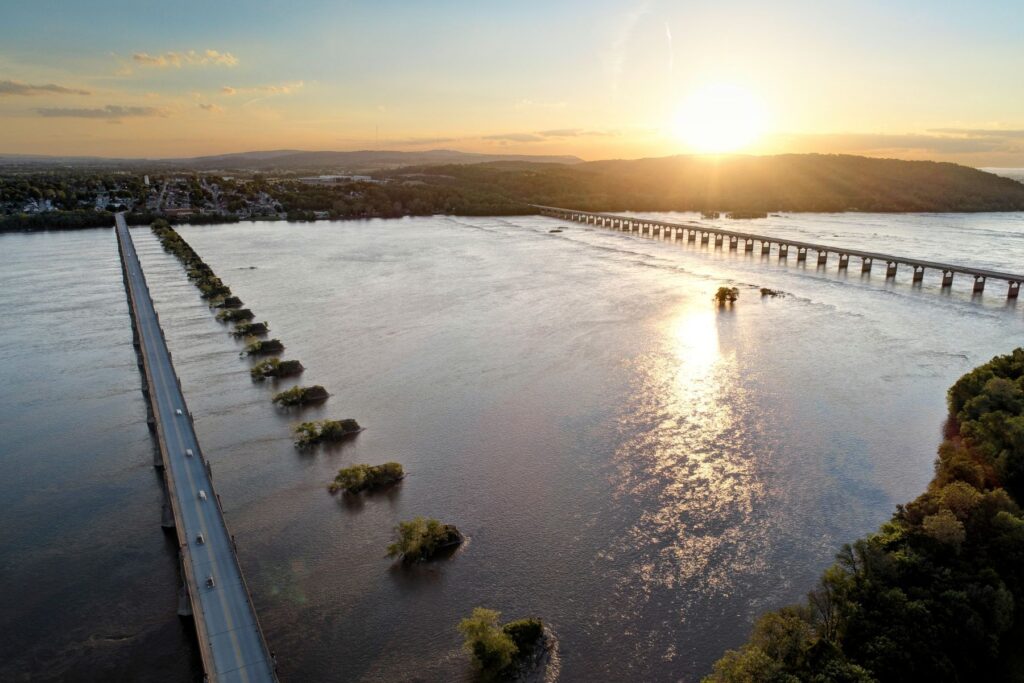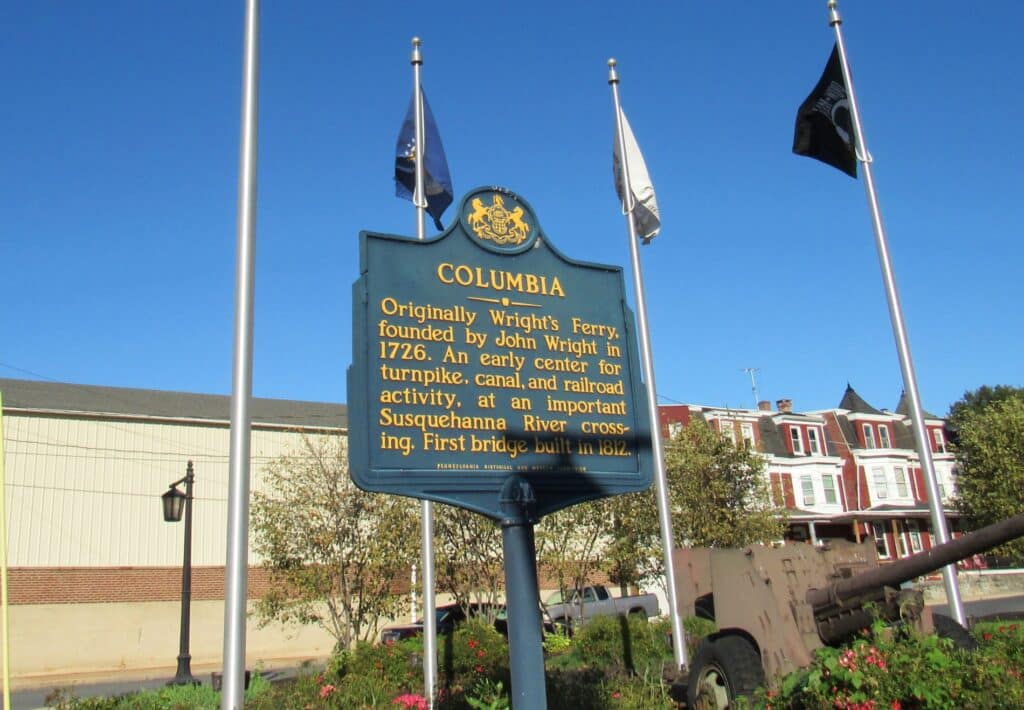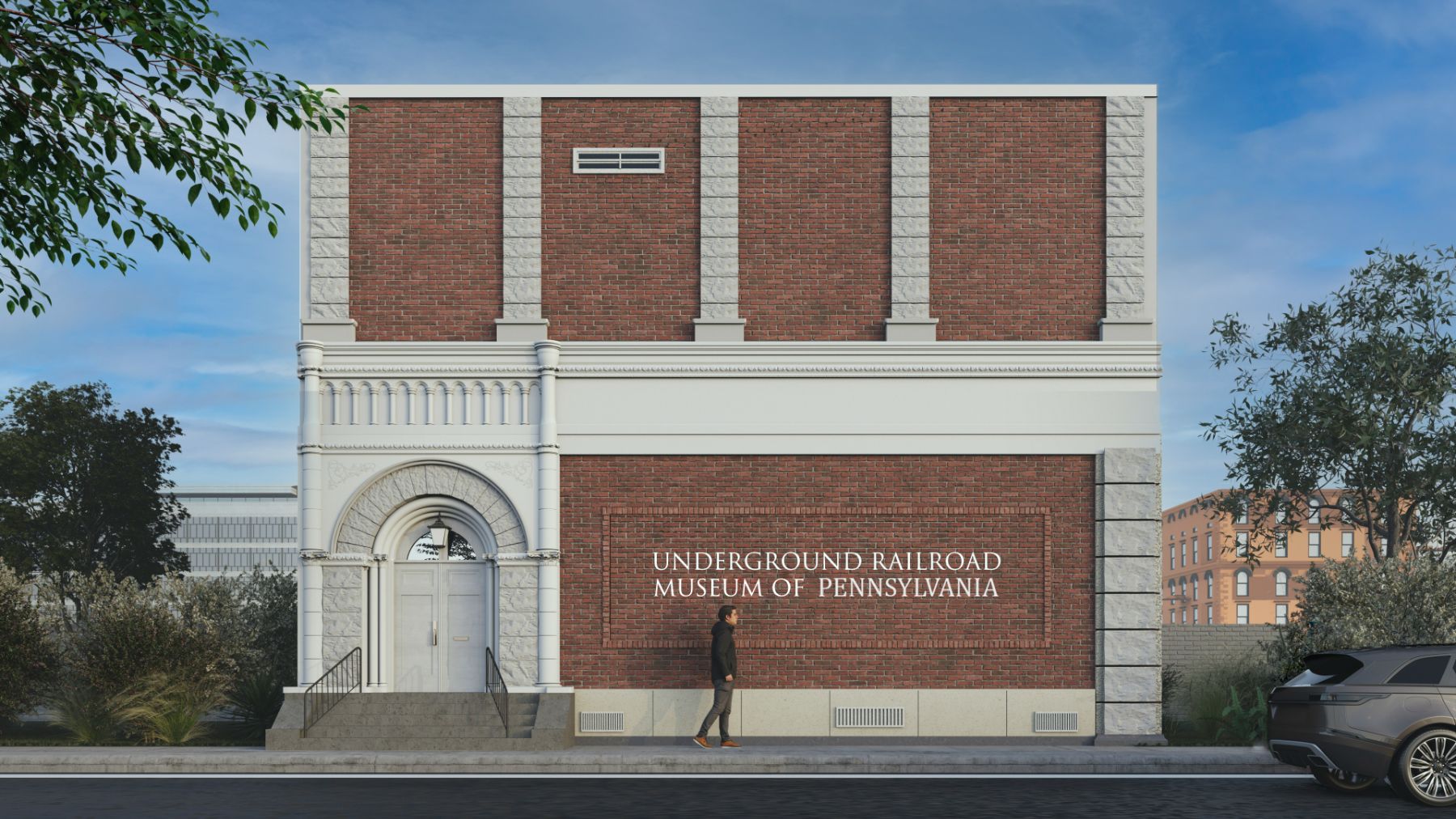$5 million heritage tourism attraction will use AI exhibit
technology to celebrate state’s role in a ‘Conspiracy of Good.’
(Columbia, PA — December 7, 2023) In 2026, the Lancaster County town of Columbia, PA, will mark its 300th anniversary. Among the highlights of that yearlong celebration will be the opening of the Underground Railroad Museum of Pennsylvania, an 8,000 sq. ft. multimedia heritage tourism attraction located on Locust Street, Columbia’s main retail district.
A significant portion of that square footage will be devoted to telling the story of Columbia’s unique role in the establishment and operation of the Underground Railroad—a story that is not only absent from most history books, but one that is still difficult for most people to comprehend.
Freedom seekers fleeing from bondage in Maryland, Virginia and points south knew that, if they could make their way across the Susquehanna to Columbia, they would find an entire town devoted to making sure they would never experience slavery again. For more than 50 years, everyone from lawyers, bankers and business leaders to shopkeepers, day laborers and everyday citizens played a role in this audacious plan. It was a conspiracy, to be sure: a Conspiracy of Good.

The Underground Railroad Museum of Pennsylvania will create an immersive experience around this idea, transporting visitors back to Antebellum Columbia and introducing them to the key players in this extraordinary effort. They include Stephen Smith and William Whipper, African-American business partners who fitted hidden compartments in their own railroad freight cars and used them to transport freedom seekers in a secret “above-ground” rail connection between Columbia and Philadelphia. Also deeply involved was William Wright, a Quaker who was an investor in the privately-owned and maintained 5,000-foot bridge that spanned the Susquehanna, and who is credited with creating the network of safehouses that formed the foundational structure of the Underground Railroad movement in this region. Many of the freedom seekers who survived the perilous journey to the western edge of the Susquehanna had to deal with possible capture and return to enslavement by bounty hunters—human traffickers who constantly patrolled these communities and the bridge that connected them. To avoid capture, untold hundreds of those freedom seekers were transported to Columbia by Robert Loney, an African-American boatman who risked life and limb to ferry the formerly enslaved across the Susquehanna River.
They are but four of the more than two dozen contributors to the Conspiracy of Good that defined Columbia and its citizens for a half-century. Their commitment, courage and creativity stands as one of the great untold stories in American history. Visitors to the Underground Railroad Museum of Pennsylvania will become intimately acquainted with this “cast of characters” through a combination of artifacts, documents, visual storytelling and wow-factor technology—including walking, talking life-sized AI-powered holograms.
The museum project is being spearheaded by The Underground Railroad Center of Columbia Pennsylvania, —“URCC” for short—a 501(c)(3) created earlier this year to lay the foundation for the work ahead. The group (www.ColumbiaURC.org) has secured an option to purchase a two-story property at 331 Locust Street, which was erected as a Masons Hall at the turn of the century and, during the town’s commercial heyday, housed a Woolworth’s on the first floor.
Floors one and two will be devoted to exhibits interpreting Pennsylvania’s contribution to the abolitionist movement and Columbia’s unique role as the “first stop” on the Underground Railroad (decades before that term actually came into use). Plans for the building’s lower/basement level include an educational space, collection storage and meeting rooms that will be offered to aligned organizations and historical societies in and around Columbia.
The URCC is approaching the Underground Railroad Museum of Pennsylvania as an economic development project for Columbia. It estimates the museum will attract 30,000 to 50,000 visitors a year, which will be a game-changer for the town. Columbia already is an established tourism destination for antique pickers, fans of Turkey Hill ice cream, and hiking-paddling-cycling along the 14-mile Northwest River Trail, which begins at Columbia Crossings.

The Underground Railroad Museum of Pennsylvania will also leverage Columbia’s other main asset—its fascinating history.
Ben Franklin lobbied to make Columbia our nation’s capital in the 1700s (it lost by a single vote). Columbia became an industrial and transportation powerhouse in the 1800s (and was home to America’s wealthiest African-American businessman). During the Civil War, the citizens of Columbia set the country’s longest covered bridge ablaze to prevent the Army of Northern Virginia from marching to Philadelphia and Washington (which stranded Robert E. Lee in a little town called Gettysburg). Many Civil War historians believe that Confederate forces would have burned Columbia, as it was well known by then for its Underground Railroad activities. Following the Chicago Fire in 1871, Columbia passed an ordinance dictating that all homes and buildings had to be made of brick (today there are nearly 1,000 of these structures still standing in a town of just 10,000 residents).

“The reason we know so much about historic events like these in Columbia is because the details were recorded and reported,” explains Mark Stewart, a member of the group that formed the 501(c)(3). “The people who established and operated the Underground Railroad in Columbia weren’t writing anything down, of course, so teasing out the details of how it worked and who was involved can be a challenge. What we do know is that this Conspiracy of Good was a generational conspiracy. It lasted for at least 50 years, the final 10 of which made it a federal crime to aid a ‘fugitive slave,’ which came with significant jail time and an enormous fine.”
The Underground Railroad Museum of Pennsylvania is one of three ambitious projects being undertaken
in the region. To the east, LancasterHistory is transforming the two historic properties in Downtown Lancaster as the Thaddeus Stevens and Lydia Hamilton Smith Center for History and Democracy. Owned by Stevens and Smith from 1842 until 1884, these buildings are being transformed into an interactive museum and community education facility, with a proposed 2025 opening. As a young lawyer, Stevens—a fierce opponent of slavery and discrimination—was deeply involved in Columbia’s Conspiracy of Good—and, of course, later served in the U.S. Congress and helped to enact the key Constitutional Amendments of the 1860s. To the west, across the river in Wrightsville, the Mifflin farmstead is being transformed into the 87-acre Susquehanna Discovery Center & Heritage Park, including an Underground Railroad Learning Center, by the Susquehanna National Heritage Area (SNHA).
“It is safe to say that the face of heritage tourism in the Susquehanna Valley is going to have a very new look in the near future,” Stewart adds.

And Columbia, located between Wrightsville and Lancaster on Rte. 30, is ideally positioned to be its geographical hub. The economic impact is likely to be dramatic and profound, as is the national exposure Columbia can expect from the museum’s unique approach to the telling of this important story.
“The Masons Hall is tailor-made for a museum, and a museum of national significance on Locust Street will create a dramatic increase in year-round foot traffic downtown.”
Don Murphy, President – Cimarron

“I am pleased to see this community begin realizing such a meaningful project,” says Zena Howard, Cultural and Civic Practice Chair at Perkins&Will, the architects of the National Museum of African American History and Culture. “In this era of racial justice truth-telling—as we daylight patterns across local histories—it is critical that these projects are not just actuated but recognized on a national level.
“I not only appreciate the impact of this work,” Howard adds, “but the forward-looking spirit shared by the individuals guiding its progress.”
The individuals who currently make up the URCC’s organizing group represent a confluence of diverse skills and experience:
The individuals who currently make up the URCC’s organizing group represent a confluence of diverse skills and experience:
• Donna L. Kreiser is a public finance attorney and member-in-charge of the Lancaster office of McNees, Wallace & Nurick LLC, a multistate firm that handled the URCC’s 501(c)3 work and continues to provide pro bono services.
• Ryan Moore, a litigator with Klehr, Harrison, Harvey, Brazenberg LLC in Philadelphia, is also providing pro bono legal services.
• Carole Bitts, in her dual career as a television producer and educator, has interpreted the Underground Railroad for adults and children for more than 25 years.
• Mark Stewart, a non-fiction author who purchased the William Wright home in 2021, has written and edited more than 100 books and has also worked on museum design projects.
• Roche FitzGerald owns Roche Design in Lancaster, a company specializing in interior surface design.
• Daisy Pagan is a longtime Columbia business owner who brings decades of retail and event-coordination to the table.
• Kimberly Fletcher is a Human Resources and Talent Development VP, as well as an experienced voice actor.
For Fletcher and Pagan, the project sparks a multitude of emotions.
“I am thrilled that Columbia and its brave, bold residents will finally receive recognition for serving as a quiet powerhouse during this critical, and dark movement in American history,” says Fletcher. “As an African-American woman living in rural Pennsylvania, the construction of an Underground Railroad museum, so close to my backyard, is of utter importance to me. The museum will educate attendees on historical data, local history and will serve as a testament to the humanitarian efforts of an entire town.”

The museum holds deep resonance for Pagan, as well.
“My mother’s great-grandmother was born into slavery,” Pagan says. “My own great-grandmother, who lived well into her hundreds, shared stories about her mother’s experiences that fascinated me, but also filled me with a sense of sadness for the hardships endured by my ancestors. I am grateful that I have the opportunity to play a role in preserving and sharing the stories of those who sought freedom in our town, bridging the gap between the past and the present.”
Having secured a location for the Underground Railroad Museum of Pennsylvania, the URCC moves into the next phase of the project, which involves building a board of trustees that can guide the museum’s progress, as well as initiating its fundraising efforts. In addition to corporate and individual donors, the URCC has begun pursuing grants and economic development funds, as well as partnerships with local and national foundations, museums and historic organizations.
“The outreach to Underground Railroad scholars and academics is a crucial step,” says Bitts. “We have a wealth of knowledge on this topic in our own backyard, as well as regionally and nationally. Ideally, they will become the thought leaders for the URCC on a board level, working alongside those with museum-design and economic development expertise. We also plan to create an advisory board for those who may not have the time to build a museum from the ground up, or whose current museum commitments may present some conflict of interest.”

The building on Locust Street was offered to the URCC by Cimarron Investments, which has spearheaded several historic redevelopment projects in Columbia. The agreement includes terms that enable the URCC to work toward the 2026 opening without financial risk or responsibility for at least two years.
“The Masons Hall is tailor-made for a museum, and a museum of national significance on Locust Street will create a dramatic increase in year-round foot traffic downtown,” explains Cimarron president Don Murphy. “Its impact on nearby restaurants and shops, as well as the Columbia Market House directly across the street, is going to be dramatic. That’s good for Columbia and also aligns with our redevelopment investments—so we view this unusually flexible agreement with the Underground Railroad group as a win-win. We are all-in, all the way.”
In addition to Perkins&Will, the URCC has also initiated conversations with well-known exhibit designers and several tech firm in the US and abroad.
“The Underground Railroad story of Columbia is not only unique in America, it is uniquely uplifting,” says FitzGerald. “We plan to double-down on the inherent appeal of what happened in this town by creating a truly unforgettable museum experience. When visitors look up, look down and look around, they will be surrounded by a level of visual storytelling that will be breaking a lot of barriers. If it’s cool, we’re looking at it. No one is going to leave here without wanting to tell everyone they know about what they just experienced.”
Ideally, the most profound “walk-away” impact of the Underground Railroad Museum of Pennsylvania will be the question visitors ask themselves as they come to understand the stunning complexity and personal commitment that defined Columbia’s Conspiracy of Good: What would I have done?
#####
For more information, visit ColumbiaURC.org or call (717) 461-3491.
The Underground Railroad Center of Columbia Pennsylvania is a 501(c)(3) with offices at 430 Walnut Street, Suite 301, Columbia PA 17512.
The Underground Railroad Center of Columbia Pennsylvania (URCC) is dedicated to the dual mission of 1) establishing a state-of-the-art Underground Railroad Museum and 2) creating a game-changing economic development engine for downtown Columbia. The museum will utilize leading-edge exhibit technology, including AI-powered holography, to tell the compelling stories of freedom seekers and the Pennsylvanians who aided them—and leverage Columbia’s unique status as ground zero for an awe-inspiring “Conspiracy of Good”—to supercharge the town’s appeal as a heritage tourism destination.



